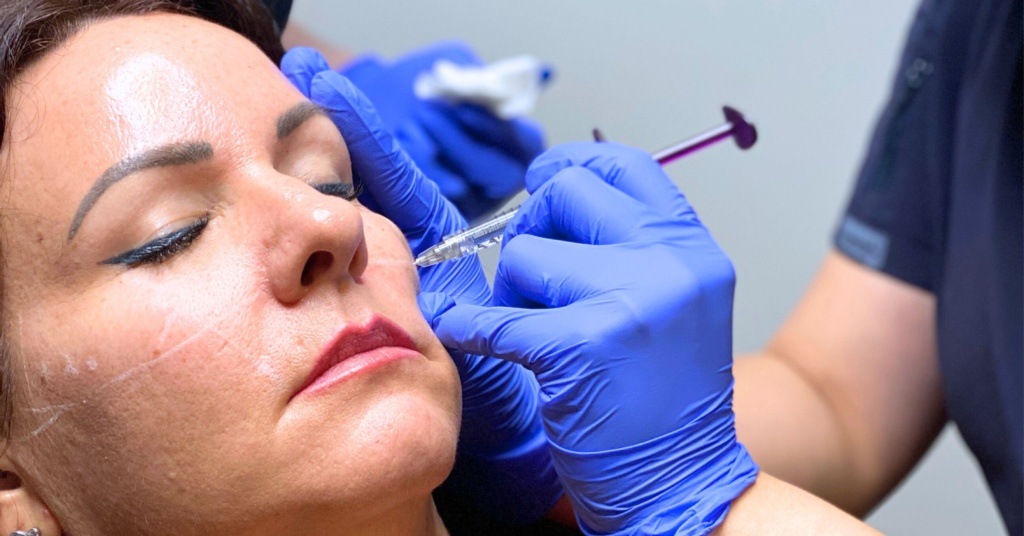Aesthetic treatments and cosmetic procedures are experiencing rapid growth, driven by increasing patient interest in aesthetic procedures. This surge has created a wealth of nursing career opportunities, with cosmetic nursing roles expanding substantially throughout Australia.
Cosmetic nursing is a growing field that offers nurses the opportunity to use their skills in a new and exciting way. However, the transition to cosmetic nursing requires specialised aesthetic training and hands-on experience.
Short courses are a great way for nurses to gain the essential skills needed for precise cosmetic injection techniques. Most aesthetic procedures require accuracy within 2-5mm, so it is important to have the proper training. These specialised programs not only support nurses in developing the technical skills needed for success in aesthetics, but also help them hone their client communication abilities. Strong communication skills are essential for building rapport with clients and ensuring their satisfaction.
Transitioning to cosmetic nursing can be a great way for nurses to advance their careers. With the right training and experience, nurses can find themselves in high demand in this growing field.
This article covers everything in cosmetic injectable training – from facial anatomy to consultation skills. You’ll learn about choosing the right training path and developing clinical expertise and advanced techniques that build a successful injectable practice, helping you make an informed decision.
Understanding Cosmetic Injectable Fundamentals
Let’s explore cosmetic injectables by looking at two main types that the Therapeutic Goods Administration (TGA) has approved. These products include:
- Botulinum toxin type A – Temporarily paralyses facial muscles that cause wrinkles
- Dermal fillers – To restore volume and facial structure to specific facial areas
A deep understanding of facial anatomy is vital for safe injectable administration. Current and future health practitioners need detailed knowledge of facial blood vessels, nerves and musculature to ensure the safe and optimal treatment outcomes. This knowledge helps prevent serious complications because incorrect placement by cosmetic practitioners could lead to skin damage, blindness or other adverse effects.
Safety protocols follow strict AHPRA guidelines. Every injectable treatment requires a valid prescription from an authorised prescriber – a medical doctor or nurse practitioner. The prescriber must complete a full consultation with the patient before any treatment begins.
Our short courses for nurses and doctors highlight the importance of cosmetic injectables as serious medical procedures. Treatment facilities must comply with strict infection control standards. Practitioners must keep detailed records of client consultations, treatments, follow-up care and of the schedule 4 medication. Within our cosmetic injecting courses, practitioners learn to manage potential complications and provide the right aftercare instructions.
Choosing the Right Training Path
Nurses who want to excel in cosmetic injectables need the right practice pathway with industry training. Let us help you pick a course that fits your career goals in a competitive field.
AHPRA-approved Course Options
Performing cosmetic medical and surgical procedures requires specialised training and adherence to strict guidelines. The Australian Health Practitioner Regulation Agency (AHPRA) mandates that healthcare professionals undertaking these procedures must possess the necessary training, expertise, and experience, not only to perform the procedure itself, but also to manage all routine aspects of care and any potential complications. This is clearly outlined in the National Board of Australia’s Guidelines for Registered Medical Practitioners Who Perform Cosmetic Medical and Surgical Procedures, specifically section 8, “Training and Experience.”
These guidelines emphasise that practitioners should only perform procedures for which they are adequately trained (8.1). Critically, for medical practitioners transitioning their scope of practice to include cosmetic procedures, the guidelines stipulate that the necessary training must be undertaken before providing these services (8.2). This ensures patient safety and maintains professional standards within the field. Meeting these AHPRA requirements, including ongoing Continuing Professional Development (CPD) related to cosmetic procedures, is essential for all practitioners in this field. This CPD can include activities such as performance reviews and outcome measurements, further reinforcing the commitment to safe and effective practice.
Certification Requirements
The National Board of Australia’s Guidelines for Registered Medical Practitioners Who Perform Cosmetic Medical and Surgical Procedures outlines specific requirements for practitioners offering these services. While there isn’t a specific “certification” in the traditional sense, the guidelines emphasize the importance of appropriate training and experience before undertaking cosmetic procedures. Therefore, prerequisites for cosmetic injectable training should reflect these principles.
Specifically, section 8 of the guidelines, “Training and Experience,” dictates that procedures should only be performed by practitioners with the appropriate training, expertise, and experience (8.1). For those transitioning into cosmetic procedures, the necessary training must be completed before providing these services (8.2). This aligns with the requirement for current AHPRA registration as a registered nurse or medical practitioner, as this registration demonstrates a foundation of medical training. While a minimum age of 18 is a standard requirement, it’s crucial to emphasize that simply being a registered practitioner over 18 does not qualify someone to perform cosmetic injectables. The focus must be on obtaining the specialized training mandated by the NBA guidelines.
Furthermore, guideline 10.3 mandates Continuing Professional Development (CPD) relevant to the practitioner’s scope of practice. For those performing cosmetic procedures, this CPD must include activities related to those procedures, such as performance reviews and outcome measurements. This reinforces the ongoing nature of training and the commitment to safe and effective practice within the cosmetic procedures field.
Training Duration and Formats
Flexible learning options make it easier to complete your training. Our Fundamentals of Cosmetic Injecting Course entails three days of clinical hands-on training, while our Foundations of Cosmetic Injecting Course is a 10-day hands-on training program. Alongside the hands-on practical training, these courses provide online theoretical learning.
While a standard class size would be six students, we guarantee just TWO students per program. This means a more effective and intimate learning environment.
Developing Essential Clinical Skills
Precise cosmetic injection techniques are the cornerstone of our cosmetic injectable training. Successful outcomes depend on both technical skill and a deep understanding of facial aesthetics.
Injection Techniques and Precision
Our short courses for nurses provide specialised training in cosmetic injection techniques, each requiring distinct expertise:
- Linear threading – ideal for lips and nasolabial folds
- Serial puncture – perfect for superficial dermal filler treatments
- Cross-hatching and fanning – essential for larger treatment areas
Blunt cannulas are preferred over sharp needles when possible, as they significantly reduce the risk of vascular injury – a key consideration covered in our short courses.
Product Knowledge and Selection
Understanding product characteristics is vital to achieve optimal results. Practitioners must know how different fillers interact with facial tissues and their composition. Our cosmetic nurse courses teach proper product storage, preparation and selection based on the specific treatment areas.
Managing Complications
Complications can occur even with meticulous technique. Quick recognition and intervention are vital. Practitioners learn to identify and manage adverse events such as:
- Vascular occlusion – requiring immediate hyaluronidase treatment
- Infection – necessitating prompt antibiotic intervention
- Nodule formation – managed through specific protocols
Risk minimisation starts with a full pre-treatment consultation and proper aftercare instructions. Regular emergency drills and complications management protocols help practitioners maintain their skills. Hands-on practice sessions build the confidence needed to handle unexpected situations effectively.
Building Your Injectable Practice
Our practical experience teaching short courses for nurses shows that establishing a successful injectable procedure needs more than technical expertise. Exceptional client care starts with becoming skilled at consultation.
Client Consultation Skills
The original consultation builds the foundation for client trust and treatment success. Practitioners should create a welcoming environment where clients feel comfortable discussing their aesthetic goals. A complete approach to consultations includes:
- Medical history assessment
- Facial analysis under natural lighting
- Discussion of realistic expectations
- Photography documentation (with consent)
- Alternate treatment options that may be available
Treatment Planning
Developing tailored treatment plans is vital for client satisfaction. Our cosmetic clinic courses emphasise the importance of complete documentation and informed consent. Practitioners must decline treatment if they believe it doesn’t serve the client’s best interests.
We train aesthetic nurses to recognise potential psychological concerns, particularly in cases of body dysmorphic disorder, and to make appropriate referrals when necessary. This integrated approach will give a high professional standard of patient care.
Documentation and Follow-up Care
Detailed record-keeping plays a key role in tracking client progress and ensuring optimal health outcomes. Our training emphasises documenting:
- Pre-treatment photographs
- Treatment details and products used
- Post-treatment instructions
- Follow-up appointment schedules
Follow-up care significantly impacts building long-term client relationships. Regular review appointments help assess results, address concerns and adjust treatment plans. Our integrated approach to practice management helps nurses develop thriving aesthetic practices that prioritise client satisfaction and safety.
Your Next Step
Health professionals can find exciting career opportunities in cosmetic injectable nursing when they’re ready to expand their expertise. Success in this field just needs specialised training, deep anatomical knowledge and a commitment to the highest safety standards.
Technical proficiency forms the foundation of injectable procedures. However, our clinical experience highlights that effective client consultations and thorough documentation are equally essential. Ensuring patient safety and practitioner compliance requires strict adherence to AHPRA guidelines.
While technical proficiency forms the basis of injectable procedures, our extensive clinical experience tells us that client consultations and thorough documentation are also essential. Patient safety and strict adherence to AHPRA guidelines must always remain a priority.The first steps into cosmetic injectables might feel overwhelming. Our expert trainers can help you select the right training path and answer your questions about moving into aesthetic medicine. We recommend detailed education that combines theoretical knowledge with hands-on practice. This approach will give a practitioner both confidence and competence needed in this rewarding career.





